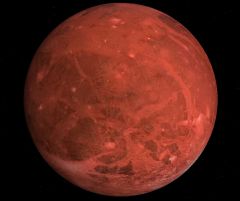Difference between revisions of "28978 Ixion"
Jump to navigation
Jump to search
(Created page.) Tag: Removed redirect |
m (Arvil moved page User:Arvil/Sandbox02 to 28978 Ixion: Move to article page.) |
(No difference)
| |
Latest revision as of 13:20, 11 October 2024
| 28978 Ixion | |
|---|---|

| |
| 28978 Ixion from Kuiper Objects Pack.zip in Orbiter 2006P1 | |
| Designation | |
| Name | 28978 Ixion |
| Reference body | Sun |
| Planetary mean orbits | |
| Epoch | 2005.71598173516 |
| Semimajor axis (a) | 5914965169039 m |
| Eccentricity (e) | 0.241252 |
| Inclination (i) | 19.6134° (0.342318407512224 radian) |
| Longitude of the ascending node (LAN, ☊) | 71.0268° (1.239651517843398 radian) |
| Longitude of periapsis (ϖ) | 110.499999998012° (1.92858882341904 radian) |
| Mean longitude (L) | 24.70671° (0.431213436835408 radian) |
| Selected physical parameters | |
| Mean radius | 880000 m |
| Mass | 2.773×1017 kg |
| Rotation elements | |
| SidRotPeriod | 86400 seconds (24 hours) |
| SidRotOffset | 0 |
| Obliqutiy | 0.535467015 |
| LAN | 0 |
| Note | *Elements given are from Ixion.cfg (Kuiper Objects Pack.zip) |
28978 Ixion (2001 KX76) is a large Kuiper Belt object and possibly a Dwarf planet and is also classified as a plutino, an object in a 3:2 resonance orbit with Neptune. It was discovered on 22 May 2001 by the Deep Ecliptic Survey at the Cerro Tololo Observatory in Chile.
28978 Ixion in Orbiter[edit]
28978 Ixion is modeled as an 800 km body. It was introduced to Orbiter with the release of the add-on Kuiper Objects Pack.zip in August 2006.
| Add-on | Source | Version | Author | Type | Release Date | Compatibility | Wiki article |
|---|---|---|---|---|---|---|---|
| Kuiper Objects Pack | O-F Resources | 2006-08-10 | markl316 | Scenery | 11 August 2006 | ||
See also[edit]
Gallery[edit]
Ixion imaged by the HST in February 2006
from Wikimedia CommonsIxion imaged by the Wide Field Imager at the La Silla Observatory in Chile in 2001
from Wikimedia Commons
| edit The Solar System | |
|---|---|
| Central star |
Sun (Sol) |
| Planets |
Mercury - Venus - Earth - Mars - Jupiter - Saturn - Uranus - Neptune |
| Natural satellites |
Moon - Phobos - Deimos - Io - Europa - Ganymede - Titan - more... |
| Add-ons |
Planets - Dwarf Planets - Small objects - Natural satellites - Alternative star systems |


